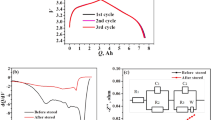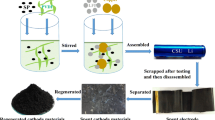Abstract
A large amount of conducting materials has typically been blended with transition metal oxides (MxOy, M = Fe, Co, Ni, Cu), and their electrochemical properties as the anode in lithium-ion batteries have been studied. Here, we report that a higher content of the conducting material results in poorer cycling stability of Co3O4. From the analysis of the cumulative irreversible capacity loss, a high content of conducting material is proven to promote irreversible electron consumption for the growth of a polymeric surface layer which is the origin of degradation. Furthermore, its formation is mathematically modeled on the basis of the Butler–Volmer relation. From the physical parameters of the polymeric surface layer determined by fitting the model to the experimental data, the degradation mechanism of Co3O4 is discussed.






Similar content being viewed by others
References
Poizot P, Laruelle S, Grugeon S, Dupont L, Tarascon JM (2000) Nano-sized transition-metal oxides as negative-electrode materials for lithium-ion batteries. Nature 407:496–499
Cabana J, Monconduit L, Larcher D, Palacín MR (2010) Beyond intercalation-based Li-ion batteries: The state of the art and challenges of electrode materials reacting through conversion reactions. Adv Mater 22:E170–E192
Grugeon S, Laruelle S, Herrera-Urbina R, Dupont L, Poizot P, Tarascon JM (2001) Particle size effects on the electrochemical performance of copper oxides toward lithium. J Electrochem Soc 148:A285–A292
Dedryvère R, Laruelle S, Grugeon S, Poizot P, Gonbeau D, Tarascon JM (2004) Contribution of X-ray photoelectron spectroscopy to the study of the electrochemical reactivity of CoO toward lithium. Chem Mater 16:1056–1061
Ponrouch A, Taberna PL, Simon P, Palacín MR (2012) On the origin of the extra capacity at low potential in materials for Li batteries reacting through conversion reaction. Electrochim Acta 61:13–18
Hu YY, Liu Z, Nam KW, Borkiewicz OJ, Cheng J, Hua X, Dunstan MT, Yu X, Wiaderek KM, Du LS, Chapman KW, Chupas PJ, Yang XQ, Grey CP (2013) Origin of additional capacities in metal oxide lithium-ion battery electrodes. Nat Mater 12:1130–1136
Wang GX, Chen Y, Konstantinov K, Yao J, Ahn J, Liu HK, Dou SX (2002) Nanosize cobalt oxides as anode materials for lithium-ion batteries. J Alloy Compd 340:L5–L10
Yang S, Cui G, Pang S, Cao Q, Kolb U, Feng X, Maier J, Müllen K (2010) Fabrication of cobalt and cobalt oxide/graphene composites: Towards high-performance anode materials for lithium ion batteries. Chem Sus Chem 3:236–239
Wu ZS, Ren W, Wen L, Gao L, Zhao J, Chen Z, Zhou G, Li F, Cheng HM (2010) Graphene anchored with Co3O4 nanoparticles as anode of lithium ion batteries with enhanced reversible capacity and cyclic performance. ACS Nano 4:3187–3194
Kim H, Seo DH, Kim SW, Kim J, Kang K (2011) Highly reversible Co3O4/graphene hybrid anode for lithium rechargeable batteries. Carbon 49:326–332
Jayaprakash N, Jones WD, Moganty SS, Archer LA (2012) Composite lithium battery anodes based on carbon@Co3O4 nanostructures: Synthesis and characterization. J Power Sources 200:53–58
Hang BT, Doi T, Okada S, Yamaki J (2007) Effect of carbonaceous materials on electrochemical properties of nano-sized Fe2O3-loaded carbon as a lithium battery negative electrode. J Power Sources 174:493–500
Cho HM, Park YJ, Yeon JW, Shin HC (2009) In-depth investigation on two- and three-electrode impedance measurements in terms of the effect of the counter electrode. Electron Mater Lett 5:169–178
Cho HM, Park YJ, Shin HC (2010) Semiempirical analysis of time-dependent elementary polarizations in electrochemical cells. J Electrochem Soc 157:A8–A18
Cho HM, Shin HC (2010) Analysis of cell impedance for the design of a high-power lithium-ion battery. In: Dahlin GR, Strom KE (eds) Lithium batteries: research, technology and applications. Nova Science, New York, pp 73–118
Fischer A, Jindra J, Wendt H (1998) Porosity and catalyst utilization of thin layer cathodes in air operated PEM-fuel cells. J Appl Electrochem 28:277–282
Thackeray MM, Baker SD, Adendorff KT, Goodenough JB (1985) Lithium insertion into Co3O4: A preliminary investigation. Solid State Ionics 17:175–181
Larcher D, Sudant G, Leriche JB, Chabre Y, Tarascon JM (2002) The electrochemical reduction of Co3O4 in a lithium cell. J Electrochem Soc 149:A234–A241
Fu ZW, Wang Y, Zhang Y, Qin QZ (2004) Electrochemical reaction of nanocrystalline Co3O4 thin film with lithium. Solid State Ionics 170:105–109
Uchida I, Sato H (1995) Preparation of binder‐free, thin film LiCoO2 and its electrochemical responses in a propylene carbonate solution. J Electrochem Soc 142:L139–L141
Shin H-C, Pyun S-I (1999) An investigation of the electrochemical intercalation of lithium into a Li1−δCoO2 electrode based upon numerical analysis of potentiostatic current transients. Electrochim Acta 44:2235–2244
Shin H-C, Pyun S-I (2001) Investigation of lithium transport through lithium cobalt dioxide thin film sputter-deposited by analysis of cyclic voltammogram. Electrochim Acta 46:2477–2485
Hengguo W, Delong M, Xiaolei H, Yun H, Xinbo Z (2012) General and controllable synthesis strategy of metal oxide/TiO2 hierarchical heterostructures with improved lithium-ion battery performance. Sci Rep 2:701–708
Kaina S, Wentao L, Yongmei L, Wenguang Z, Hui Y, Jiqing X, Zuyan L, Shu-Lei C, Lingzhi Z, Ronghua Z (2015) A novel shuttle-like Fe3O4–Co3O4 self-assembling architecture with highly reversible lithium storage. RSC Adv 5:70527–70535
Fransson L, Eriksson T, Edström GT, Thomas JO (2001) Influence of carbon black and binder on Li-ion batteries. J Power Sources 101:1–9
Fong R, Sacken U, Dahn JR (1990) Studies of lithium intercalation into carbons using nonaqueous electrochemical cells. J Electrochem Soc 137:2009–2013
Winter M, Novák P, Monnier A (1998) Graphites for lithium‐ion cells: the correlation of the first‐cycle charge loss with the brunauer‐emmett‐teller surface area. J Electrochem Soc 145:428–436
Safari M, Morcrette M, Teyssot A, Delacourt C (2009) Multimodal physics-based aging model for life prediction of Li-ion batteries. J Electrochem Soc 156:A145–A153
Pinson MB, Bazant MZ (2013) Theory of SEI formation in rechargeable batteries: capacity fade, accelerated aging and lifetime prediction. J Electrochem Soc 160:A243–A250
Débart A, Dupont L, Poizot P, Leriche JB, Tarascon JM (2001) A transmission electron microscopy study of the reactivity mechanism of tailor-made CuO particles toward lithium. J Electrochem Soc 148:A1266–A1274
Verma P, Maire P, Novák P (2010) A review of the features and analyses of the solid electrolyte interphase in Li-ion batteries. Electrochim Acta 55:6332–6341
Nielsen LE (1966) Simple theory of stress–strain properties of filled polymers. J Appl Polym Sci 10:97–103
Wu CL, Zhang MQ, Rong MZ, Friedrich K (2002) Tensile performance improvement of low nanoparticles filled-polypropylene composites. Compos Sci Technol 62:1327–1340
Acknowledgments
This research was supported by the National Research Foundation of Korea Grant (NRF-2011-C1AAA001-0030538) and the Global Frontier R&D Program (2013M3A6B1078877) on Center for Hybrid Interface Materials (HIM), funded by the Ministry of Science, ICT & Future Planning, Korea.
Author information
Authors and Affiliations
Corresponding author
Rights and permissions
About this article
Cite this article
Choi, WS., Hwang, S., Chang, W. et al. Degradation of Co3O4 anode in rechargeable lithium-ion battery: a semi-empirical approach to the effect of conducting material content. J Solid State Electrochem 20, 345–352 (2016). https://doi.org/10.1007/s10008-015-3050-1
Received:
Revised:
Accepted:
Published:
Issue Date:
DOI: https://doi.org/10.1007/s10008-015-3050-1




